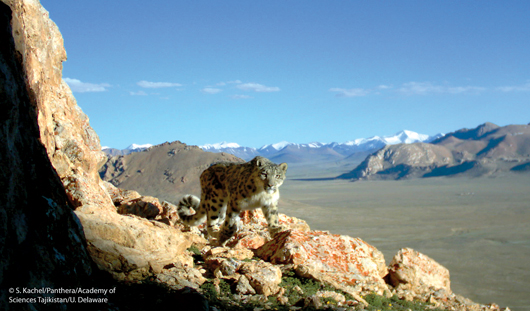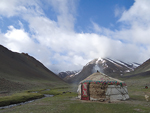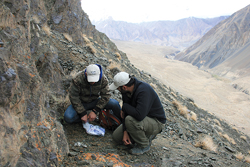Remote monitoring spots endangered snow leopards

RESEARCH | As he lay in a bathtub, seeking shelter from the barrage of mortar attacks just outside his building, Shannon Kachel realized that the new violence meant that his summer of studying snow leopards, ibex and Marco Polo sheep in the desolate mountain ranges of Asia was over.

Fortunately for the UD graduate student, in the two months he had already worked in the Pamir Mountains region of Tajikistan, he had managed to set up some 80 cameras in rugged terrain covering an area about half the size of the state of Delaware. And those cameras have yielded results, as Kachel—working with Kyle McCarthy in the Department of Entomology and Wildlife Ecology—studies the snow leopard population, whose numbers have dropped precipitously in recent decades.

Kachel went to Tajikistan last summer to study wild ungulate, or hooved mammals, and snow leopards to determine all the variables surrounding the species and to seek clues to their population sizes. He set up cameras in two distinct areas of the Pamirs.
“What I’m doing is comparing those two sites, one for the availability of the ungulate prey, but then the snow leopard populations, as well,” Kachel says. While hunting and poaching is a concern, his research is focused more on the impact that pastoral communities have on the snow leopard.
“A lot of that population loss results from the typical poaching pressures that we think of, from people going out and killing big cats, but a bigger component is competition with pastoral people,” he says.
He explains that as government food subsidies dried up with the fall of the Soviet Union, an artificially high human population was left in the area, compared with what the environment could support. In this high and desolate region of the world, people turned to livestock production and the killing of wild ungulates in order to sustain themselves.
“The component that I’m addressing is more from the ecological perspective,” Kachel says. “The other side of having all these livestock on the landscape is that it reduces the amount of natural prey that’s available for snow leopards. And it gets rid of all the forage available for, specifically in my study area, the ibex and the Marco Polo sheep.”
His research received funding from Panthera, a global wild cat conservation group, and help from the Tajik Academy of Sciences. He hiked the area, setting up lures and cameras that operate based on heat and motion.
“We needed to make sure that any animal passing by was present long enough to get clear images,” Kachel says. “So we used the lure to draw them in and hold their attention. We need clear images so we can identify the individual cats” based on the pattern of their spots.
“We can use our observations of when, where and how frequently individuals are caught by the cameras to build better population estimates that tell us more than a simple minimum count,” he says.
The cameras, which were retrieved by a Tajik man once the violence ended, caught pictures of two snow leopard cubs, which drew international attention when they were highlighted by Reuters and in Business Insider.
“I’m actually really optimistic about how many pictures we’ve gotten back in terms of snow leopard outlook and the prognosis for the species,” Kachel says. “The global population estimate ranges from 3,500-7,000 animals, and that’s a huge range.”
If these preliminary results are borne out, he says, the data would give conservationists another tool to protect snow leopards and their prey throughout their range.
Article by Adam Thomas






